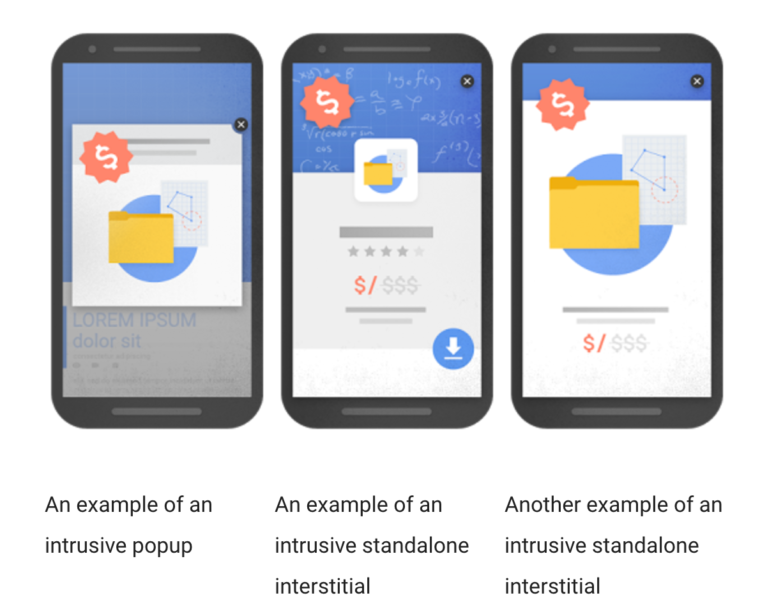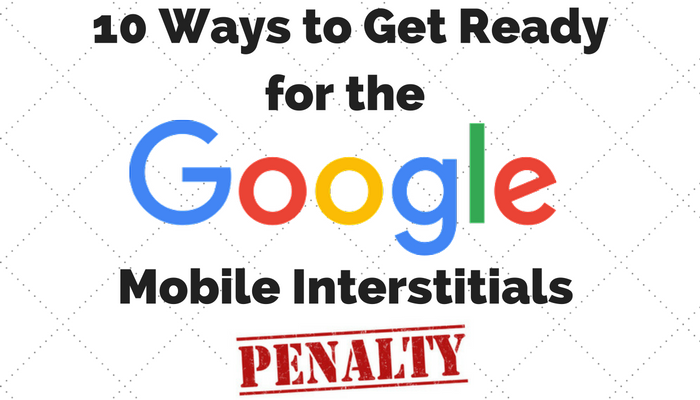Google announced back in August 2016 that it will begin to devalue web pages in mobile search with intrusive interstitials as of January 10, 2017. Going forward, Google recommends using interstitials on mobile pages that only take up a “reasonable” amount of screen space.
Here is an example of what Google considers to be “intrusive”:

Google gave site owners plenty of time to prepare for the update, but in case you have not yet done so, I have rounded up 10 pieces of expert advice that will ensure your web pages are not affected by this penalty.
How to Avoid Google’s Mobile Interstitials Penalty
Advice from Google
The first piece of advice comes from none other than Google itself. Here’s how Google defines the penalty:
“To improve the mobile search experience, after January 10, 2017, pages where content is not easily accessible to a user on the transition from the mobile search results may not rank as highly.”
Takeaway: Content on the pages you have indexed in mobile search must be readily available when a user clicks through to the page from Google.
Be Honest With Yourself: Do Your Pop-Ups Serve a Purpose?
Ben Silverman from Brafton Marketing shares this advice:
“The easiest way to avoid the mobile interstitial and pop-up penalty is to think like Google, whose main objective is to make the internet more accessible, browsable, intuitive and honest, especially for mobile browsers. This means there are some exceptions to Google’s pop-up policy: If yours serves a real, honest purpose, chances are you’ll be okay.”
Takeaway: Some pop-ups are still acceptable if they are either required by law, such as age verification, or if they don’t detract from the main content on the page, such as a small banner at the top.
Hiding Content With Ads is Now Against Google Guidelines
The Verge shares this advice:
“For the most part, Google is targeting overlays that gray out the content beneath them to prevent you from reading a website, either for a few seconds or until you find and very carefully tap a little X to dismiss them.”
Takeaway: Publishers may not be happy about this, but ads that are displayed over top of the main content are no longer acceptable. This includes ads that appear when you land on a page, as well as ads that appear as you scroll down a page. There should be no barrier preventing a user from reading content on the page at any time.
Ad Publishers Need to Adapt and Look Into New Strategies
HubSpot’s Senior Product Marketing Manager, Marcus Andrews, shares this advice:
“…if they haven’t done so already, marketers solve for mobile SEO first. The pain that comes with changing a revenue model is inevitable, but shorter-term – and businesses that rely on advertiser dollars, should figure out ways to make money that don’t totally disrupt the mobile user experience.”
Takeaway: Removing revenue-generating interstitials might hurt at first, but losing organic search traffic could hurt even more. Therefore, site owners must adapt and look for non-intrusive ways to generate revenue.
Develop a Content Marketing Strategy for Generating Revenue
Sitepoint shares this advice:
“The consistent creation and distribution of relevant content attracts users without beating them with a hard-sell stick. Use content—including blog posts, round-ups, guides, videos, infographics, and more—to educate audiences and guide them through the buying process.”
Takeaway: Since the goal of Google’s interstitials penalty is to make content more accessible, use that to your advantage. Develop a content marketing strategy to sell users on your products and services, rather than intrusive pop-up ads.
Mobile-Friendly Label is Being Removed for All Sites, But Being Mobile-Friendly Still Matters
Syed Balkhi of OptinMonster shares this advice:
“The first part of the announcement that a lot of journalists skipped over is that the “mobile-friendly” label that Google is currently displaying in search results will be removed for everyone on January 10, 2017… Since over 85% of all pages in mobile search results now meet the criteria, they will be removing the label for everyone.”
Takeaway: Google will no longer consider pages with intrusive interstitials as being mobile-friendly, but don’t panic once you don’t see the “mobile-friendly” label next to your content in search results. The label is being removed for everyone, although being mobile friendly is still as important as it has ever been.
Intrusive Interstitials Not Allowed on Mobile, But Desktop is Still OK
Icegram shares this advice:
“Use display targeting rules in your popup / interstitial program, and show them only on desktop / larger screens. Don’t use popups and interstitials on mobile. Instead use smaller messages like banners, inlines or slide ins.”
Takeaway: You don’t have to remove intrusive pop-up ads and interstitials altogether, you only need to remove them on mobile pages. They can still be displayed on desktop browsers without incurring any kind of penalty.
Check Your WordPress Plugins
Sarah Gooding of WP Tavern shares this advice:
“WordPress users who use plugins to display pop up messages, whether it’s for coupons, membership offers, promotions, or another form of advertising, will want to carefully review Google’s size guidelines or consider a different approach for reaching visitors.”
Takeaway: If you use WordPress plugins to display interstitials, staying in compliance with Google’s new guidelines may be as simple as adjusting sizes using the plugin settings. Remember, keep them small and non-obtrusive. Content should be the main focus of the page.
Interstitials Triggered by Exit Intent Are Still Allowed
Google’s John Mueller shared this advice when asked if the penalty would apply to pages with an interstitial triggered on exit intent:
“At the moment those wouldn’t count. What we’re looking for is really interstitials that show up on the interaction between the search click and going through the page and seeing the content. So that’s kind of the the place we’re looking for those interstitials. What you do afterwards, like if someone clicks on stuff within your website or closes the tab or something like that then that’s kind of between you and the user.”
Takeaway: Interstitials triggered by exit intent are perfectly fine. Google is only targeting interstitials that appear when a user lands on a page.
Page-to-Page Interstitials Will Not Be Penalized
Google’s John Mueller again shared his advice when asked if the penalty only applies to pages that users land on from Google’s search results:
yes
— John ☆.o(≧▽≦)o.☆ (@JohnMu) January 4, 2017
Takeaway: Google is not looking to penalize all pages with interstitials, only the ones which searchers can land on from search results. It’s still OK to display an interstitial when a user navigates from one of your pages to another.
Conclusion
Google is always looking for new ways to improve the search experience. The intent behind devaluing pages with intrusive interstitials is to help users find the content they need without being bombarded by pop-ups. There’s no doubt this will require a period of adjustment for site owners who have been displaying interstitials up until this point, but in the end it could lead to more time on site, more pageviews per visit, and a lower bounce rate. There are both positive and negative aspects to this update — site owners just have to keep rolling with Google’s proverbial punches.
For more information, I recommend listening to SEJ’s recent Marketing Nerds podcast where SEJ Executive Editor Kelsey Jones sits down with Simon Schnieders and Edward Kreiman from Blue Array to talk about the upcoming mobile interstitials penalty in detail.




